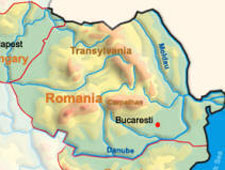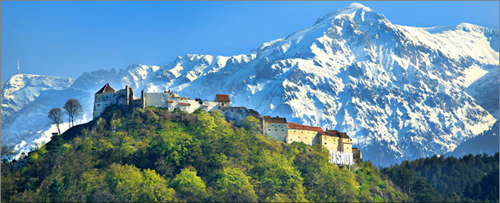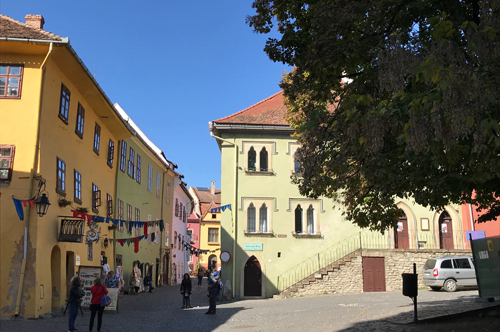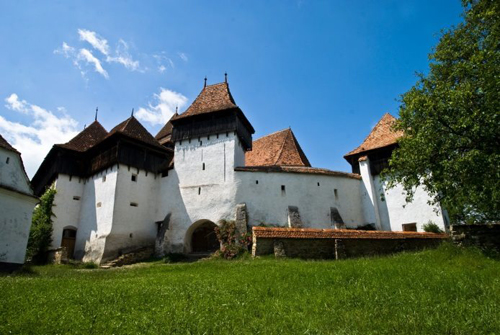|
|

|
|
|
|
Horseback riding vacations in
Romania
 Travel back in time to Transylvania on a horseback tour through mysterious Romania. Gallop across vast green fields while weaving in and out of hay stacks, climb steep mountains for breathtaking views and experience the incredible history of Romania on a horse riding holiday. Experience ancient monasteries, organic and local produce, shepherds who spend their days in fields and a dark sky scattered with stars. On a Romanian horse, you will find it all! Travel back in time to Transylvania on a horseback tour through mysterious Romania. Gallop across vast green fields while weaving in and out of hay stacks, climb steep mountains for breathtaking views and experience the incredible history of Romania on a horse riding holiday. Experience ancient monasteries, organic and local produce, shepherds who spend their days in fields and a dark sky scattered with stars. On a Romanian horse, you will find it all!
Horse Riding in Romania
Romania is perhaps most famous throughout the world for Transylvania – the home of Bram Stoker’s Dracula. Transylvania is a land of mountains and forests, folklore and tradition, hospitality and mystery, and to this day Transylvania remains Europe's best-kept secret.
On a horse riding holiday in Transylvania you will discover traditional folk villages, where horses still plough the fields. Here, the food is grown on small traditional farms, and the tranquility will inspire you – back to a time before the hustle and bustle of modern day machines. Monasteries sit on quiet hillsides, and forests shelter an abundance of wildlife. In Transylvania, you will discover locals who are unaffected by the stresses of modern life, and welcome you to their little slice of heaven. Experience all this the same way the locals do, from the back of a horse!
Hidden Trails has several horse riding holidays available in Transylvania.
The Transylvanian Ride will introduce you to the forested hills made famous in the movie Cold Mountain – horse and man work together in the fields and country houses scatter the landscape.
The Carpathian Mountains Ride takes in medieval villages and some of Europe’s oldest fortified churches.
The History and Nature Ride will guide you through Central and Eastern Europe’s largest area of pristine nature – the Carpathian Mountains.
Finally, the Szekler and Saxon Land trips go deep into the hinterland where different ethnical groups made their home.

Romania Weather and Climate
Temperature averages are: April 11°C; May 16°C; June 19°C; July 21°C; August 21°C; September 18°C; October 13°C. It may be about 5 degrees hotter at midday and 5 degrees colder at nightfall. Showers are possible at any time. The sun will be warm and bright in the clear mountain air.
Explore more European Horse Riding Vacations
|
|
Holidays on horseback in Romania
See Mini Country Guide
|
Below is a list of our trips in this area with video clips.
 Click on the 'watch video' icon

to view a video clip,
Romania
Travel restrictions
Visitors and residents arriving in Romania from any country in the world do not need to present proof of vaccination (complete scheme) or a negative RT-PCT test.
The requirement to complete a Passenger Locator Form / Declaration has been voided.
Measures taken by the government
As of May 1st 2022, all Covid restrictions have been lifted.
Testing
The list of accredited facilities in Romania certified for RT-PCT COVID-19 testing can be found on the website of the Romanian Ministry of Health at http://www.ms.ro/centre-testare/
These facilities will prioritize tests for hospitalized patients, individuals suspected of being infected with COVID-19 and individuals who are in a high risk group. Depending on their availability, they may perform testing on demand and may set the cost of the tests performed on demand.
The cost of COVID-19 testing on demand varies between $15 – $70 and is paid for by you. Test results are delivered by email and text message.
Emergency number (related to COVID-19) while visiting the country
The official Romanian toll-free number for COVID-19 information (in Romanian) is 0800800358.
Source:
US Embassy in Romania https://ro.usembassy.gov/covid-19-information/
Published on October 5th 2022 (checked on April 5th 2023)
RomaniaTourism.com - Romania Travel Advisory http://romaniatourism.com/travel-advisory.html
Published on April 4th 2023 (checked on April 5th 2023)
For more information please visit our COVID-19 Updates page at https://www.hiddentrails.com/article/covid19update.aspx
|
|
Romania
At A glance
Capital City: Bucharest
Land size: 229,891 sq km
Population: 18,519,899 (2022 est.)
Official language: Romanian
Currency: Leu (lei / RON)
UNESCO properties and sites:
- Churches of Moldavia
- Dacian Fortresses of the Orastie Mountains
- Historic Centre of Sighişoara
- Monastery of Horezu
- Roșia Montană Mining Landscape
- Villages with Fortified Churches in Transylvania
- Wooden Churches of Maramureş
- Ancient and Primeval Beech Forests of the Carpathians and Other Regions of Europe
- Danube Delta
Source: https://www.cia.gov/the-world-factbook/countries/romania/
Romania boasts rich history, diverse landscapes, and warm hospitality. Explore the vibrant capital city of Bucharest, with its blend of old-world charm and modern delights. Discover the medieval treasures of Transylvania, from the iconic Bran Castle to the picturesque towns of Brasov and Sighisoara. Go on an adventure through the beautiful Danube Delta, full of wildlife and hidden treasures.
Journey into the mystical landscapes of the Carpathian Mountains, where lush green valleys, rugged peaks, and dense forests create a perfect setting for horseback riding adventures. Ride through picturesque trails that wind through traditional villages and breathtaking scenery. A horse-riding holiday through Romania will allow you to get to know the locals, tasting their food and sharing beautiful riding stories.
Brief History
The principalities of Wallachia and Moldavia - for centuries under the suzerainty of the Turkish Ottoman Empire - secured their autonomy in 1856; they were de facto linked in 1859 and formally united in 1862 under the new name of Romania. The country gained recognition of its independence in 1878. It joined the Allied Powers in World War I and acquired new territories - most notably Transylvania - following the conflict.
In 1940, Romania allied with the Axis powers and participated in the 1941 German invasion of the USSR. Three years later, overrun by the Soviets, Romania signed an armistice. The post-war Soviet occupation led to the formation of a communist "people's republic" in 1947 and the abdication of the king.
The decades-long rule of dictator Nicolae CEAUSESCU, who took power in 1965, and his Securitate police state became increasingly oppressive and draconian through the 1980s. CEAUSESCU was overthrown and executed in late 1989. Former communists dominated the government until 1996 when they were swept from power.
Romania joined NATO in 2004 and the EU in 2007.
Source: https://www.cia.gov/the-world-factbook/countries/romania/
Cultural Insights
Romanians are known for hospitality and generosity. Guests are always fed.
Romanians are friendly and open and foreigners are usually made very welcome. Chatting with visitors is very common for Romanians and they will find a way to communicate with you even if they cannot speak your language.
Older people particularly appreciate old-fashioned politeness.It is respectful to use Mrs. or Mr. when using the name of a person that you just meet.
Handshaking is the most common form of greeting. When a Romanian man is introduced to a woman, he will probably kiss her hand, strictly avoiding her eyes.
If one refuses what a host offers to eat or drink, this will often be taken as a polite refusal by guest who really means to say "yes". If you want to refuse the offer find a polite excuse or say it again.
It is common to linger once the meal (lunch or dinner) is over.
When visiting someone at home bring a small gift. Most common gifts include flowers or chocolate (for women only), a bottle of wine or liquor.
In Romania as in many Latin countries life is lived at a more relaxed pace.
It is not considered impolite to ask a person's age, politics, income or religion, so don't take such questions amiss.
Source: https://www.everyculture.com/No-Sa/Romania.html
https://romaniatourism.com/practical-information.html
Transportation
By Air
Romania currently has 12 international airports.
Bucharest Airport (OTP)
Henri Coandă Airport is Romania’s busiest international airport. It is located in Otopeni, 17 km north of the country’s capital. It is one of the two airports serving Bucharest. The other is Aurel Vlaicu Airport, which no longer serves scheduled passenger traffic. Until 2004 it was named Bucharest Otopeni Airport. The airport serves as a base for Blue Air, Ryanair and Wizz Air.
Cluj-Napoca Airport (CLJ)
The airport serving the city of Cluj-Napoca is also known under the name of Avram Iancu Cluj Airport. It is the second busiest international airport in Romania.
Timișoara Airport (TSR)
Also famous as Traian Vuia Airport, Timisoara Airport serves the same named region of Romania. The airport serves as the main air transportation hub for the Western Romania and for the Danube–Criș–Mureș–Tisa Euroregion. The airport also serves as a base for Ryanair and Wizz Air.
Târgu Mureș Airport (TGM)
Known also as Transylvania Airport, Târgu Mureș Airport is a smaller international airport situated 14km southwest of the same named city in central Romania.
Sibiu Airport (SBZ)
Sibiu Airport serves the historic city of Sibiu. The airport is located in southern Transylvania, 3km west of Sibiu and 250km away from the country’s capital city Bucharest.
By Rail
Traveling by train from other European countries to Romania takes from four hours (Budapest to Arad or to Oradea) to about 30 hours (Paris to Bucharest).
As most train tickets allow several stopovers en route, train travel can be an affordable and relaxing way to include Romania in a European trip.
First and second-class sleepers are available for journeys longer than 10 hours and for overnight trains.
Schedules of international trains to and from Romania can be obtained at www.bahn.de or www.InterRail.eu
At the present time Romania's National Rail Company (SNCFR or CFR) offers the possibility to purchase tickets on-line for domestic destinations only.
Tickets for international destinations can be purchased at any SNCFR Rail Travel Agency (Agentia de Voiaj CFR) or at ticket offices in most major train stations in Romania.
If you would like to purchase a train ticket for an international destination, before your arrival to Romania, you will need to contact a local travel agency or an international rail travel company.
Source: https://getbybus.com/en/blog/romanian-airports/
https://romaniatourism.com/transportation.html
Money
Major credit cards including American Express, Mastercard and Visa are accepted in large hotels, car rental companies and stores in the main cities.
However, credit cards may be accepted in very few places in small towns or away from tourist areas.
There is a large network of ATMs that accept standard international credit and debit cards but you may incur a fee. Check with your card provider whether you will be able to use these machines.
There are very, very few ATMs in remote areas or villages.
ATMs that have symbols for international networks such as STAR and PLUS will accept US/ Canadian banking cards.
Contrary to practice in the United States, a PIN is usually required to make credit card purchases.
Many American banks allow cardholders to establish such a PIN prior to travel, in case one is needed.
If you do not have a pin just tell the cashier "this is a no pin credit card".
Regardless, it is a good idea to notify your bank of your international travel, and the potential legitimate use of your card abroad, prior to leaving home.
Most western currencies can usually be exchanged for local currency at any of the large number of exchange bureaux in towns and cities.
Source: https://www.gov.uk/foreign-travel-advice/romania
https://romaniatourism.com/practical-information.html
Health
If you need emergency medical assistance during your trip, dial 112 and ask for an ambulance. If you are referred to a medical facility for treatment you should contact your insurance/medical assistance company immediately.
Medical care in Romania is generally not up to Western standards, and basic medical supplies are limited, especially outside major cities. Some medical providers that meet Western quality standards are available in Bucharest and other cities but can be difficult to identify and locate.
Hospitals and doctors often require payment “up front” prior to service or admission. Credit card payment is not always available. Most hospitals and medical professionals require cash payment. Travelers seeking medical treatment should therefore choose their provider carefully.
Most prescription drugs and over-the-counter medications are available in Romania but are often sold under different names. A list of approved medicines available in Romania can be found on the following Romanian National Agency for Medicines and Medical Devices website: https://www.anm.ro/nomenclator/medicamente
Always carry your prescription medication in original packaging, along with your doctor’s prescription. Check with the Romanian National Agency for Medicines and Medical Devices to ensure the medication is legal in Romania.
Source: https://www.gov.uk/foreign-travel-advice/romania
https://travel.state.gov/content/travel/en/international-travel/International-Travel-Country-Information-Pages/Romania.html
Electricity
Romania operates on a 230V supply voltage and uses type C and F plugs.
The Type C electrical plug (or Europlug) is a two-wire plug that has two round pins. It fits into any socket that accepts 4.0 – 4.8 mm round contacts on 19 mm centres. They are being replaced by E, F, J, K or N sockets which work perfectly with Type C plugs.
The Type F electrical plug (also known as a Schuko plug) has two 4.8 mm round pins spaced 19 mm apart. It is similar to the Type E plug but has two earth clips on the side rather than a female earth contact. The CEE 7/7 plug was developed to work with sockets E and F and has grounding clips on both sides (to work with Type F sockets) and a female contact (to accept the grounding pin of the type E socket).
Source: https://www.iec.ch/world-plugs
Communication
Time zone in Romania: Eastern European Standard Time (GMT+2)
International country code – 40
Romania’s telecom market has undergone several significant changes in recent years. The mobile market is served by network operators that have extensive LTE networks in place, while services based on 5G have been offered under their existing spectrum concessions since 2019.
Source: https://www.cia.gov/the-world-factbook/countries/romania/
Phrasebook
| English |
Romanian |
| Hello! |
Bună ziua |
| Goodbye |
La revedere |
| Good morning |
Bună dimineaţa |
| Good evening |
Bună seara |
| Good night |
Noapte bună |
| Please |
Vă rog |
| Thank you |
Mulţumesc |
| Yes |
Da |
| No |
Nu |
Source: https://romaniatourism.com/romanian-language.html
Entry Requirements
A valid passport is required for all overseas/ non-EU visitors. Citizens of the European Union countries can enter Romania with a valid passport or with their National Identity Card.
Your passport must be valid for the entire duration of your visit.
Although Romania is not part of the Schengen agreement, some airlines (i.e. Lufthansa) may refuse boarding at your point of origin or while transferring planes if your passport is not valid for at least three months beyond your intended date of departure.
For this reason, the U.S. Department of State – Bureau of Consular Affairs recommends that your passport has at least six months' validity remaining whenever you travel abroad.
For stays longer than 90 days visitors need to need to apply for a temporary residence permit (either before arriving into Romania or at least 30 days before the 90-day "no visa" stay expires).
American and Canadian citizens as well as citizens of Australia, New Zealand and most European countries do not need an entry visa to visit Romania, providing duration of stay is not more than 90 days.
Citizens of certain countries and territories need a visa to visit Romania.
To quickly check if you need a visa please go to www.E-Visa.MAE.ro (select the "Get Informed" tab (up left) and enter the following information: passport issuing country, type of passport, purpose of your visit to Romania).
Entry requirements and visa information are also available at www.mae.ro.
Source: https://romaniatourism.com/entry-requirements.html
Embassies and Consulates
U.S. Embassy in Bucharest
4-6, Dr. Liviu Librescu Blvd.
015118 Bucharest
Telephone: (+40) 21 200-3300
Embassy of Canada in Bucharest
1-3 Tuberozelor Street
011411 Bucharest
Telephone: (+40) 21 307-5000
Source: for USA https://www.usembassy.gov/
For Canada: https://travel.gc.ca/assistance/embassies-consulates
UNESCO Sites
Churches of Moldavia
These eight churches of northern Moldavia, built from the late 15th century to the late 16th century, their external walls covered in fresco paintings, are masterpieces inspired by Byzantine art. They are authentic and particularly well preserved. Far from being mere wall decorations, the paintings form a systematic covering on all the facades and represent complete cycles of religious themes.Their exceptional composition, the elegance of the characters, and the harmony of the colors blend perfectly with the surrounding countryside. The interior and exterior walls of the Church of the Suceviţa Monastery are entirely decorated with mural paintings of the 16th century, and this church is the only one to show a representation of the ladder of St John Climacus.
Dacian Fortresses of the Orastie Mountains
Built in the 1st centuries B.C. and A.D. under Dacian rule, these fortresses show an unusual fusion of military and religious architectural techniques and concepts from the classical world and the late European Iron Age. The six defensive works, the nucleus of the Dacian Kingdom, were conquered by the Romans at the beginning of the 2nd century A.D.; their extensive and well-preserved remains stand in spectacular natural surroundings and give a dramatic picture of a vigorous and innovative civilization.

Historic Centre of Sighişoara
Founded by German craftsmen and merchants known as the Saxons of Transylvania, Sighişoara is a fine example of a small, fortified medieval town which played an important strategic and commercial role on the fringes of central Europe for several centuries.
Monastery of Horezu
Founded in 1690 by Prince Constantine Brancovan, the monastery of Horezu, in Walachia, is a masterpiece of the 'Brancovan' style. It is known for its architectural purity and balance, the richness of its sculptural detail, the treatment of its religious compositions, its votive portraits and its painted decorative works. The school of mural and icon painting established at the monastery in the 18th century was famous throughout the Balkan region.
Roșia Montană Mining Landscape
Located in the Metalliferous range of the Apuseni Mountains in the west of Romania, Roșia Montană features the most significant, extensive and technically diverse underground Roman gold mining complex known at the time of inscription. As Alburnus Maior, it was the site of extensive gold-mining during the Roman Empire. Over 166 years starting in 106 CE, the Romans extracted some 500 tonnes of gold from the site developing highly engineered works, different types of galleries totalling 7km and a number of waterwheels in four underground localities chosen for their high-grade ore. Wax‐coated wooden writing tablets have provided detailed legal, socio‐economic, demographic and linguistic information about the Roman mining activities, not just in Alburnus Maior but also across the wider Dacian province. The site demonstrates a fusion of imported Roman mining technology with locally developed techniques, unknown elsewhere from such an early era. Mining on the site was also carried out, albeit to a lesser extent, between medieval times and the modern era. The later extractive works surround and cut across the Roman galleries. The ensemble is set in an agro-pastoral landscape which largely reflects the structures of the communities that supported the mines between the 18th and early 20th centuries.

Villages with Fortified Churches in Transylvania
These Transylvanian villages with their fortified churches provide a vivid picture of the cultural landscape of southern Transylvania. The seven villages inscribed, founded by the Transylvanian Saxons, are characterized by a specific land-use system, settlement pattern and organization of the family farmstead that have been preserved since the late Middle Ages. They are dominated by their fortified churches, which illustrate building styles from the 13th to the 16th century.
Wooden Churches of Maramureş
These eight churches are outstanding examples of a range of architectural solutions from different periods and areas. They show the variety of designs and craftsmanship adopted in these narrow, high, timber constructions with their characteristic tall, slim clock towers at the western end of the building, either single- or double-roofed and covered by shingles. As such, they are a particular vernacular expression of the cultural landscape of this mountainous area of northern Romania.
Ancient and Primeval Beech Forests of the Carpathians and Other Regions of Europe
This transnational property includes 94 component parts in 18 countries. Since the end of the last Ice Age, European Beech spread from a few isolated refuge areas in the Alps, Carpathians, Dinarides, Mediterranean and Pyrenees over a short period of a few thousand years in a process that is still ongoing. The successful expansion across a whole continent is related to the tree’s adaptability and tolerance of different climatic, geographical and physical conditions.
Danube Delta
The waters of the Danube, which flow into the Black Sea, form the largest and best preserved of Europe's deltas. The Danube delta hosts over 300 species of birds as well as 45 freshwater fish species in its numerous lakes and marshes.
Source: https://whc.unesco.org/en/statesparties/ro
|
|

|
|
|
|